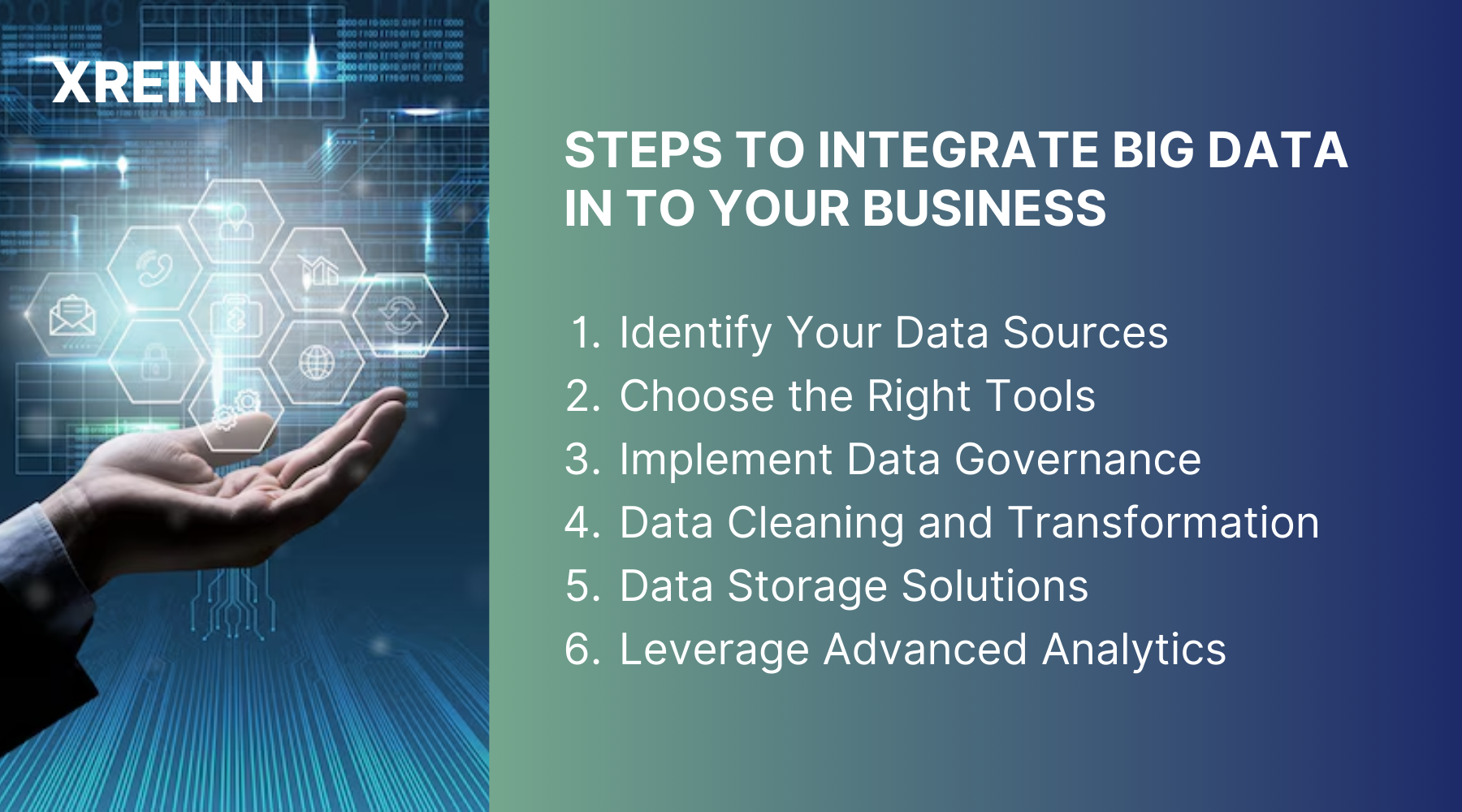Data Integration
6 Steps to Integrate Big Data into Your Business
Aug 02, 2024
Integrating big data into your business strategy is essential in the current market environment. Experts highlight that utilizing big data can lead to a 20% increase in operational efficiency and a 15% growth in customer satisfaction. For SMEs, improving data integration is important to staying relevant and creating significant growth opportunities. Additionally, effective data integration helps in making the best strategic decisions and improves overall business performance.
In this article, we will highlight these steps and the benefits of integrating big data into your business.
Understanding Big Data
Big data encompasses the large volumes of information produced from distinct sources, including digital interactions, social media activity, and transactional records. This data, when effectively utilized, provides deep insights that can drive strategic decisions and operational efficiency.
The key to unlocking the potential of big data lies in advanced analytics, which can show patterns and trends that were previously undetectable. By understanding and using big data, you can gain a competitive edge, optimize your processes, and deliver more personalized experiences to their customers.
The Importance of Data Integration
Data integration is about combining data from diverse sources to create a unified view. For SMEs, this means consolidating data from sales, marketing, customer service, and other departments. Effective data integration not only improves decision-making but also improves operational efficiency. It enables a holistic understanding of your business by eliminating data silos and facilitating comprehensive analytics.
Creating a single source of truth ensures consistency across your organization’s data. This consistency is important for generating accurate reports and insights, which are the foundation for strategic planning and performance measurement.
6 Steps to Integrate Big Data into Your Business

1. Identify Your Data Sources
Start by listing out all potential data sources within your organization. These might include CRM systems, social media platforms, website analytics, and financial records. Understanding where your data originates is the first important step in integrating it effectively. Ask yourself, "Where does our most valuable data exist?"
For a structured approach, create an extensive inventory of data sources. This inventory should catalog each source, the type of data it contains, and its significance to your business objectives. Such a systematic approach makes sure no critical data is skipped. Moreover, understanding the data flow and interaction between different systems helps in designing an effective integration strategy.
2. Choose the Right Tools
Selecting the appropriate tools is the next important step. Tools like Apache Hadoop, Talend, or cloud-based solutions like Google BigQuery and Amazon Redshift offer powerful capabilities. Assess these tools based on scalability, flexibility of use, and integration capabilities with your existing systems. For instance, if handling structured and unstructured data, Hadoop's distributed storage and processing capabilities are invaluable.
When choosing tools, customize your selection to the specific needs of your SME. offers open-source data integration and data quality tools that are highly customizable, and advantageous for businesses with unique data requirements. Conversely, cloud-based tools likeprovide scalability and flexibility, allowing your data infrastructure to evolve alongside your business.
3. Implement Data Governance
Data governance ensures data accuracy, security, and regulatory compliance. Establish policies for data quality management, data security, and compliance. Implementing a data governance framework involves delineating roles and responsibilities, setting up data stewardship programs, and ensuring continuous monitoring and auditing. This proactive approach minimizes risks and maximizes data integrity.
Start by forming a data governance committee comprising key stakeholders from various departments. This committee will oversee the development and enforcement of data governance policies. Regular training and awareness programs are essential to ensure that all employees comprehend their roles in maintaining data integrity and security.
4. Data Cleaning and Transformation
Data cleaning and transformation are vital to ensure data usability. This involves removing duplicates, rectifying errors, and standardizing formats. Employ ETL (Extract, Transform, Load) tools to automate these processes. For example, Talend's powerful data-cleaning functionalities streamline this step, ensuring your data is reliable and primed for analysis.
To implement data cleaning practically, establish a data quality checklist. This checklist should include tasks such as validating data accuracy, checking for missing values, and standardizing formats across datasets. Regular reviews and updates to this checklist help maintain high data quality over time, ensuring that your analysis is based on accurate and reliable data.
5. Data Storage Solutions
Invest in scalable and flexible data storage solutions. Cloud storage options like Amazon S3 or Google Cloud Storage provide cost-effective, scalable solutions that can grow with your business. These platforms offer the flexibility to securely store vast amounts of data and recover as needed. Consider factors such as storage costs, retrieval times, and security features when selecting your storage solution.
For instance, Amazon S3 offers various storage classes, allowing cost optimization based on data access frequency. Google Cloud Storage provides advanced security features like data encryption and access controls, ensuring your data remains protected. Evaluate these options based on your specific storage needs and budget constraints to make an informed decision.
6. Influence Advanced Analytics
Advanced analytics techniques such as predictive analytics, machine learning, and AI can transform your data into actionable insights. Use platforms like TensorFlow or SAS Analytics to construct predictive models that forecast trends and behaviors. Implement machine learning algorithms to uncover hidden patterns and anomalies in your data. These advanced techniques enable you to stay ahead of the competition by anticipating market shifts and customer needs.
To apply these techniques effectively, start with a clear business objective. For example, if your goal is to promote customer retention, analyze customer data to identify patterns and factors contributing to churn. Use predictive models to forecast which customers are likely to leave and implement targeted retention strategies based on these insights.
Benefits of Big Data Integration
1. Enhanced Decision-Making
Integrating big data improves your decision-making processes. By having a unified view of your data, you can make more informed decisions that drive business growth. For example, use integrated sales and marketing data to identify which campaigns generate the highest ROI, enabling you to allocate resources more effectively.
With integrated data, you can conduct a comprehensive analysis, considering multiple factors simultaneously. This holistic approach provides deeper insights and reveals interdependencies that might be missed when analyzing data in silos.
2. Improved Customer Insights
Big data provides profound insights into customer behavior and preferences. Analyze data from customer interactions, social media, and purchase history to create detailed customer profiles. This allows personalized marketing strategies that resonate with your target audience, improving customer engagement and loyalty.
For instance, by integrating social media data with purchase history, you can identify which products are trending among your customers. Use this information to tailor your marketing messages and offer personalized recommendations, enhancing the customer experience.
Operational Efficiency
Data integration streamlines your operations by providing a comprehensive view of your processes. Identify inefficiencies by analyzing integrated data from production, supply chain, and sales. For instance, if you notice delays in your supply chain, integrated data can help pinpoint the bottleneck, allowing you to take corrective action swiftly.
A practical approach involves setting up real-time dashboards that display key performance indicators (KPIs) from different departments. These dashboards provide instant insights into your operations, enabling quick decision-making and proactive problem-solving.
Targeted Marketing
With integrated customer data, your marketing efforts can be more targeted and effective. Use customer segmentation based on purchase behavior, demographics, and engagement to adjust your marketing campaigns. This precision targeting not only increases conversion rates but also enhances customer satisfaction.
For example, segment your customers based on their buying patterns and engagement levels. Develop personalized marketing messages and offers for each segment, ensuring your campaigns resonate with the right audience at the right time.
Conclusion
Integrating big data into your business analytics framework is a transformative strategy that offers substantial benefits. By understanding your data sources, choosing the right tools, and implementing powerful data governance, you can apply the power of big data to drive informed decision-making, improve customer insights, enhance operational efficiency, and execute targeted marketing campaigns.
As your business grows, so will the amount of data you generate. It's essential to continually refine your data strategies and accept new technologies to remain competitive. By strategically integrating big data, your SME can release new opportunities for success and achieve significant growth.

Data Analytics
Jun 27, 2024Master key concepts in data analytics with practical tips to enhance decision-making and achieve success in your projects and professional growth

Data Analytics
Jul 01, 2024Learn the essential stages of the data analytics workflow to turn your data into valuable business insights and drive growth.

